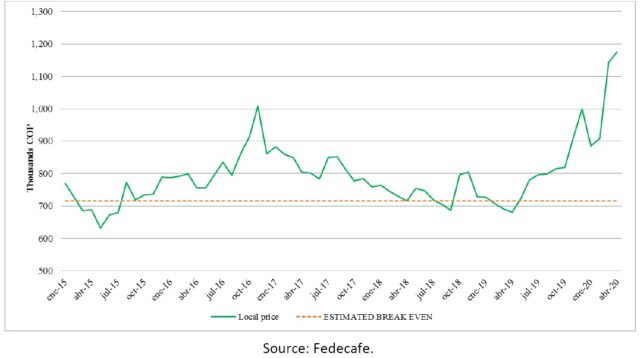Colombian domestic prices depend on the New York international price and the Colombian peso (COP) to U.S. dollar currency exchange rate. The decrease in international prices severely affected internal prices in 2018 and part of 2019. Since May 2019, the recovery of international prices and the devaluation of Colombian peso against dollar have slowly increased and maintained internal prices above estimated average productions costs ($715,000 COP/125Kg bag, approximately $208 USD). However, since the first case of Covid-19 was confirmed in Colombia, local prices have jumped to high historical levels. In March 2020, local price increased by 25.7 percent compared to the previous month, and by 65.5 percent compared to March, 2019.
This increase is motivated by higher international prices driven by stockpiling among major players that anticipate supply disruptions, and the over 20 percent Colombian peso depreciation against U.S. dollar. The graph above illustrates the monthly internal price paid to growers per 125 kilogram bag.
As reference, the estimated average production cost is illustrated by the red dotted line. Colombian coffee farmers have claimed that production costs may increase as a result of the implementation of sanitary measures and higher salaries due to shortage of labor.
In 2019, Fedecafe estimates there are 540,000 coffee growing families in 21 out of 32 Colombian departments, where small farmers with less than five hectares of land are responsible for approximately 69 percent of coffee production in Colombia.
There are approximately 860,000 hectares of coffee planted in the country. Nearly 800,000 correspond to technified crops, meaning they are partially planted with improved coffee varieties, such as rust resistant trees, dense plantations and are younger than 12 years old.
As a result of a successful replanting program and the implementation of agronomic best practices, the planting density increased to 5,232 trees per hectare, the area planted with rust resistant varieties reached 82.4 percent, with productivity at historically high levels of 20.5 bags GBE per hectare, and the average age of coffee plantations was reduced to 6.7 years. If the number of renovated hectares is at least 80,000 per year, the Colombian productivity potential will remain around 14.7 million bags GBE.

